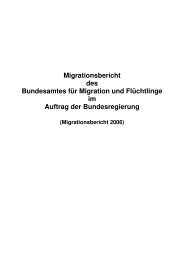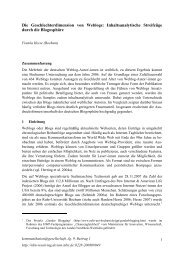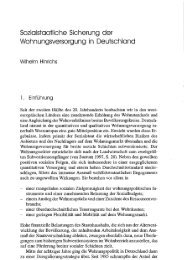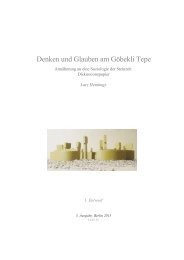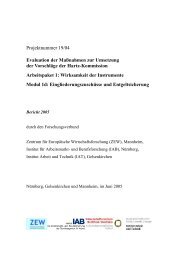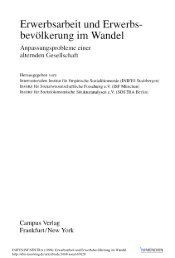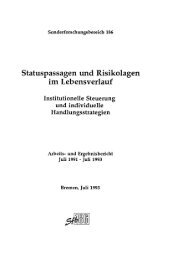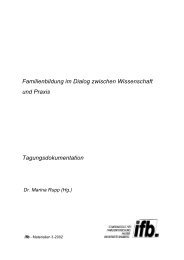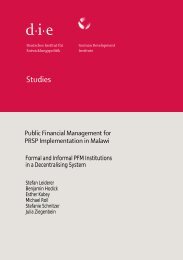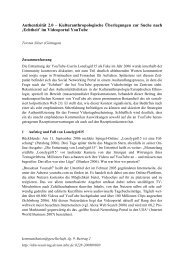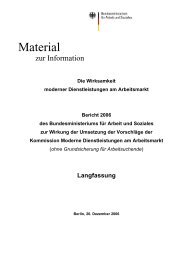Sharing Knowledge: Scientific Communication - SSOAR
Sharing Knowledge: Scientific Communication - SSOAR
Sharing Knowledge: Scientific Communication - SSOAR
Erfolgreiche ePaper selbst erstellen
Machen Sie aus Ihren PDF Publikationen ein blätterbares Flipbook mit unserer einzigartigen Google optimierten e-Paper Software.
The C 2 M project: a wrapper generator for chemistry and biology 269<br />
cification task, however, suggests a preference for languages that describe constraints<br />
on solutions rather than procedures for finding solutions. 4 In the wrapper<br />
domain, this preference translates into one for wrappers built from high-level,<br />
declarative descriptions of the formats involved. Indeed, RYO wrappers in a<br />
procedural language are generally hard to read and maintain, particularly so<br />
over intervals of a year or more. CORBA’s IDL objects suffer from the same defect.<br />
On the positive side, RYO wrappers present a flexible, lightweight approach<br />
to resource interoperability, wholly in line with the dynamic nature of<br />
science on the Web. The way out is to use wrapper generators. A wrapper generator<br />
generates wrappers from high-level descriptions. Because implementation<br />
details are hidden from view, wrapper generators facilitate the task of building<br />
and maintaining RYO wrappers. The main fundaments of wrapper generators<br />
are known from compiler building. 5 An approach to wrapper generation has<br />
been published fourteen years ago by Mamrak and co-workers. 6 Since then,<br />
many approaches to wrapper generation have been published. The WWW<br />
Wrapper Factory (W4F) approach 7 resembles C2M but is largely confined to<br />
XML formats. The C2M language bears resemblance to the idea of token-templates.<br />
8 Automated wrapper generation 9 and wrapper verification 10 have also received<br />
attention.<br />
C2M builds on these experiences to present a wrapper generator that facilitates<br />
the design and maintenance of RYO wrappers. It is not intended to supplant<br />
existing software for regular conversion jobs. Rather, C2M supports irregular<br />
jobs such as extracting a table with protein-protein interactions from the<br />
4 For example, B.W. van Schooten, Development and specification of virtual environments,<br />
Ph.D. thesis, Parlevink group,University of Twente, Enschede, the Netherlands, 2003,<br />
chapter 5; also available as http://wwwhome.cs.utwente.nl/~schooten/proefschrift.pdf;<br />
B. Khazaei and C. Roast, “The usability of formal specification representations”, in: G. Kadoda<br />
(ed.), Proceedings of the 13th Workshop of the Psychology of Programming Interest<br />
Group, Bournemouth UK, April 2001, pp. 305—310.<br />
5 The classic text on compiler building is A.V. Aho and J.D. Ullman, Principles of compiler<br />
design, Reading MA: Addison-Wesley, 1979.<br />
6 S.A. Mamrak, M.J. Kaelbling, C.K. Nicholas, and M. Share, “Chameleon: a system for solving<br />
the data-translation problem”, IEEE Transactions on Software Engineering, 15<br />
(1989), 1090—1108; S.A. Mamrak, C.S. O’Connell, and J. Barnes, The integrated Chameleon<br />
architectures, Englewood Cliffs NJ: Prentice Hall, 1994.<br />
7 A. Sahuguet and F. Azevant, “Building intelligent Web applications using lightweight<br />
wrappers”, Data and <strong>Knowledge</strong> Engineering 36 (2001), 283—316.<br />
8 B. Thomas, “Token-templates and logic programs for intelligent web search”, Journal of<br />
Intelligent Information Systems 14 (2000), 241—261.<br />
9 N. Kushmerick, “Wrapper induction: efficiency and expressiveness”, Artificial Intelligence<br />
118 (2000), 15—68; P.B. Golgher, A.H.F. Laender, A.S. da Silva, and B. Ribeiro-Neto,<br />
“An example-based environment for wrapper generation”, in: S.W. Liddle, H.C. Mayr, and<br />
B. Thalheim (eds.), Conceptual Modeling for E-Business and the Web, Berlin: Springer,<br />
2000, pp. 152—164.<br />
10 N. Kushmerick, “Wrapper verification”, World Wide Web 3 (2000), 79—94.




